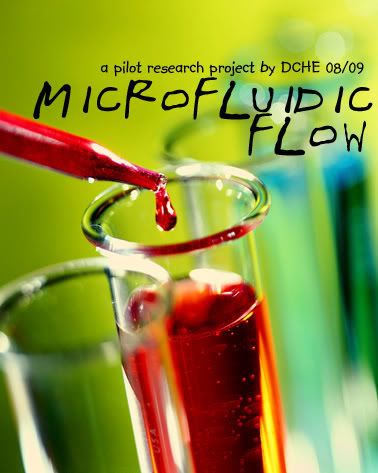the gantt chart
Friday, January 16, 2009

comment? (0)
towards the end - weeks 31, 32, 33, 34
Phase V: Conduct PIV StudyMonth of December
What have we learnt?
• We have learnt how to set up the equipment and apparatus to create a height difference to produce a pressure-driven flow.
• We made use of the Dynamic Studio software to study the particles flow under pressure-driven conditions using various PIV correlations methods.
• We carried out two experiments: two inlet streams without height difference and two inlet streams with height difference.
• For two inlet streams without height difference, the flow is relatively laminar due to low Reynolds number. Mixing is negligible and the flow is towards one direction.
• For inlet streams with height difference, the flow is near to turbulence due to higher pressure applied. Moreover, at the junction where the two inlet streams meet, some mixing is observed from the vectors diagram obtained. However, after the junction and towards the straight channel, the flow becomes laminar and more orderly. Mixing is not observed in that section.
• In short, Reynolds number and pressure do affect flow regime in micro-channel and also contribute to mixing.
Equipment Set-up
As mentioned in previous log entry, we placed our micro-slide on the stage and use the microscope to adjust the focus settings. In Dynamic Studio software, we had to manually re-adjust the knob again to get a better focus on the channel image since the focus on the micro-scope and the focus in the software are different.
Next, the two inlet streams of the micro-channel are connected to two syringe tubes which are then attached to two different syringes. For the first experiment with no height difference between the inlet streams, both the syringes were suspended at the same level above the ground. The syringes were supported with a retort stand. In the second experiment, one inlet syringe is placed at a higher elevation than the other stream to create a height difference.
As for the outlet stream, a syringe tube is connected from the channel outlet to a syringe which is suspended at a height level below the inlet two inlet streams. By doing this, we are creating a pressure-driven force in which the two inlet streams at higher elevation will travel towards the outlet at lower elevation. This is true since the as the height from the ground increases, pressure will also increase.
Dynamic Studio
After the set-up, we carried out our experiments using the Dynamic Studio software.
At the start, calibration is carried out to obtain the the width of the channel so as to obtain the vector, the speed at which the solid particles are moving.
Next, after carrying out pre-experimental settings, the actual acquiration of images is performed. After that, using the images captured, we performed various cross-correlations and masking PIV techniques to get reliable vector diagrams which represent the actual flow of particles. Unwanted regions and vector arrows are removed and masked off. Only wanted regions are kept.
Experiments
Our purpose of doing an additional experiment in which there is height difference between the two inlet streams is to study whether turbulence will be experienced in such condition. Furthermore, by having two different variables, we can make comparisons in our results to note any difference in observations in terms of flow regimes and presence of mixing as well as results.
Problems Encountered / Solution
Several of the problems encountered include problem in removing air bubbles, and distribution of light source on the micro-channel. Removing the air bubbles is a difficult task as the tube is required to be flushed completely with the liquid. At the same time, there is a risk of forming new air bubbles. In order to counter this, we had to flush the tube with the liquid very slowly and patiently so that the probability of forming new bubbles is decreased.
Furthermore, ideal distribution of light source on the channel is also hard to achieve as the light source will never be evenly distributed throughout the image of the channel. In our case, when adjusting the light source, the light was either too concentrated on the channel or too dim. These problems will affect our results especially during the PIV techniques application is performed. As a solution, we adjusted the brightness and the position of the micro-strobe to ensure the light is not too bright and not too dim and focus on the section of the channel which we are interested. Unwanted regions are purposely left in the shadows.
Phase VI: Electro-kinetics
In this phase, we are basing our project on past year’s FYP project on micro-pumps and will be going into further observatory details. We are able to conduct further observatory studies through our FYP’s topic and equipments using micro PIV. This enables us to see how particles flow from one point to the other than just 1 particle by calculating manually the speed of the particle. By having this micro PIV, we are able to see how fast is each particle is moving and in what direction in vector charts by using the micro PIV software. By re-conducting the experiment the previous group has done earlier, we are able to see it visually how the particles move and behave under electric supply. For example, by studying the vector charts a little more detail, the particles vibrates forward and back ward while moving, the particles move from the negative to the positive thus it is suggested that this is caused by electrophoretic forces and electro-osmotic forces acting together.
comment? (0)
